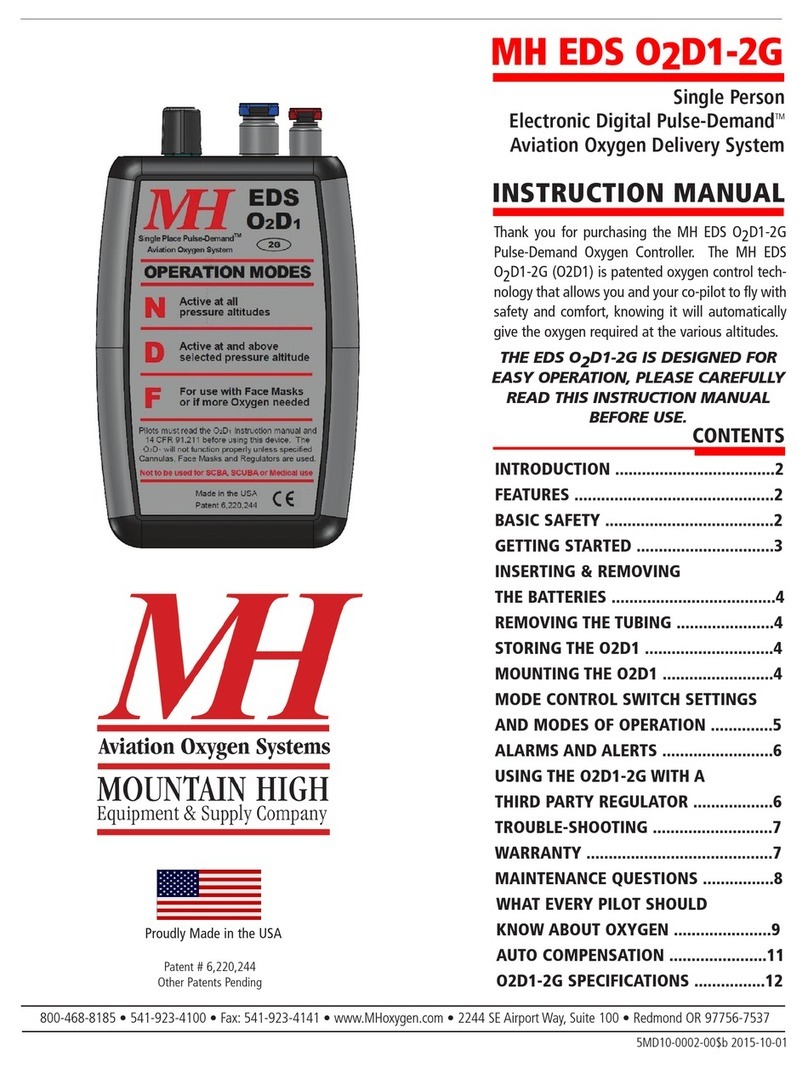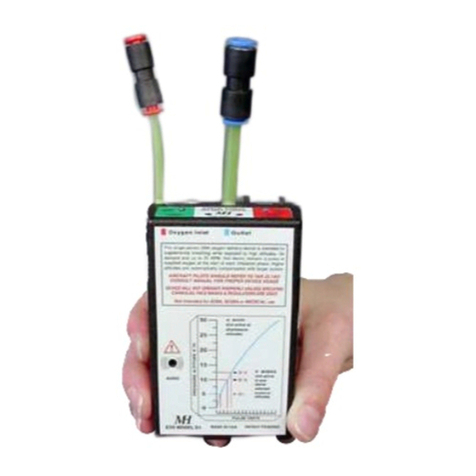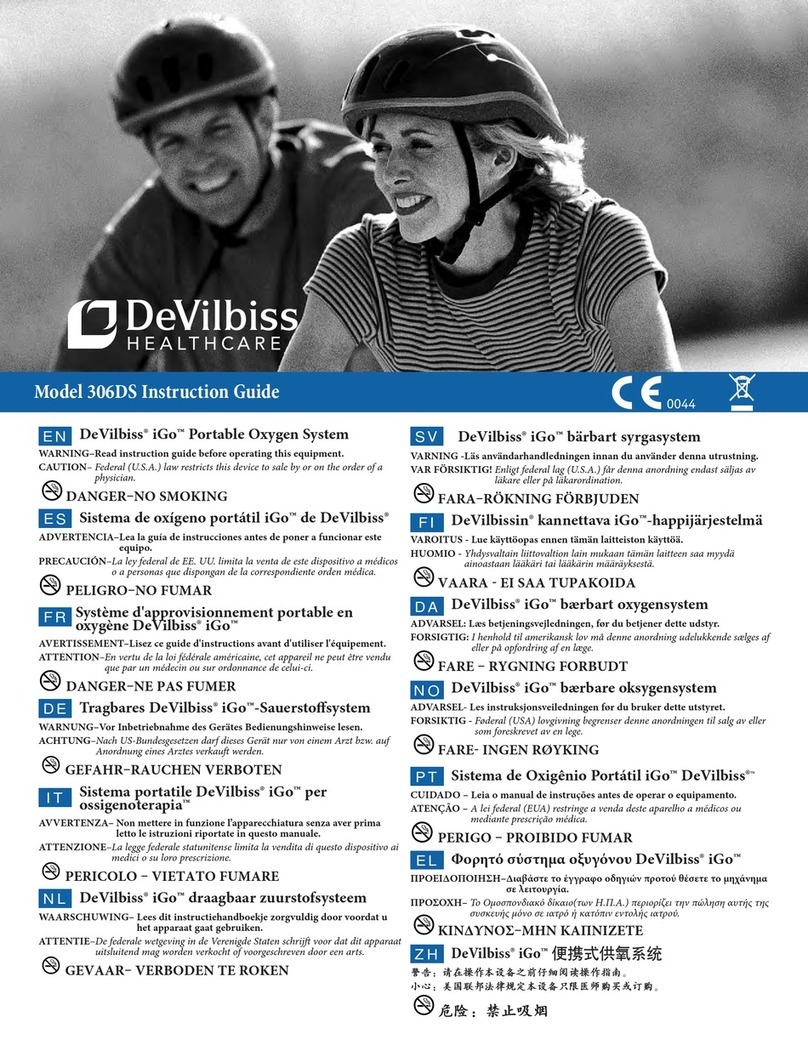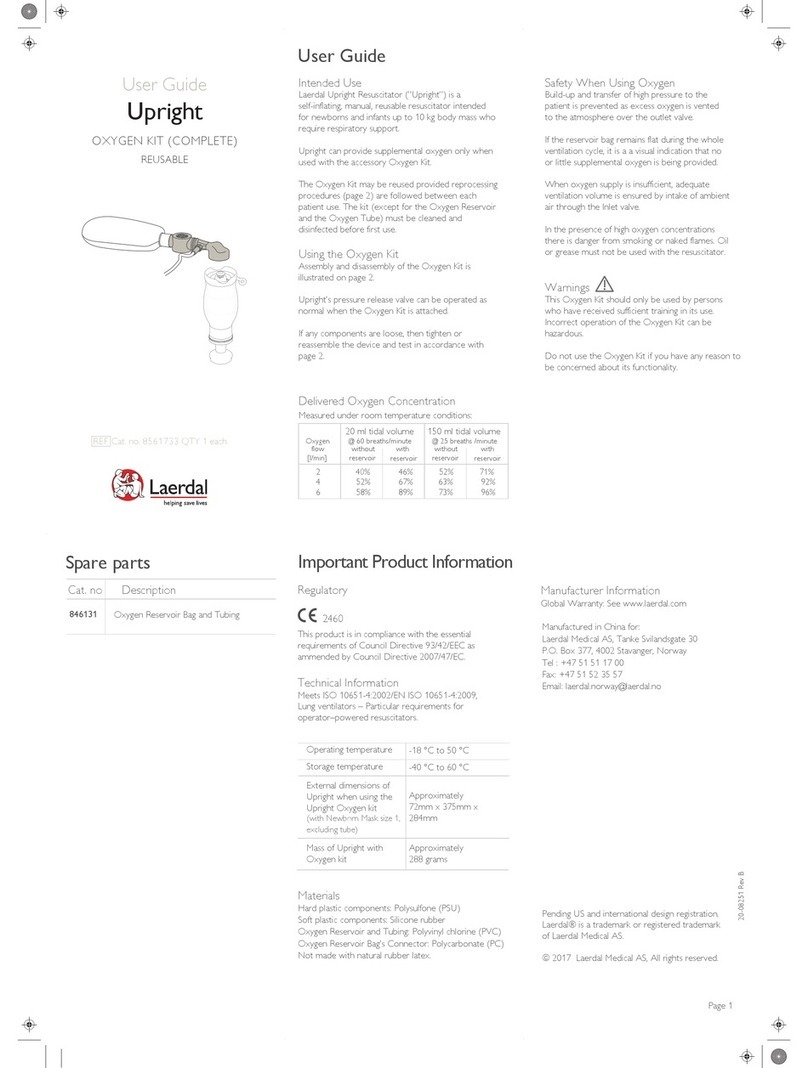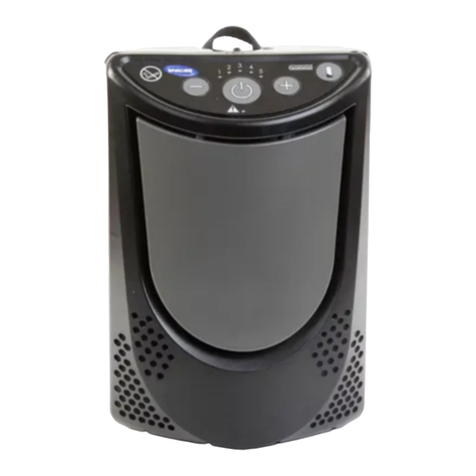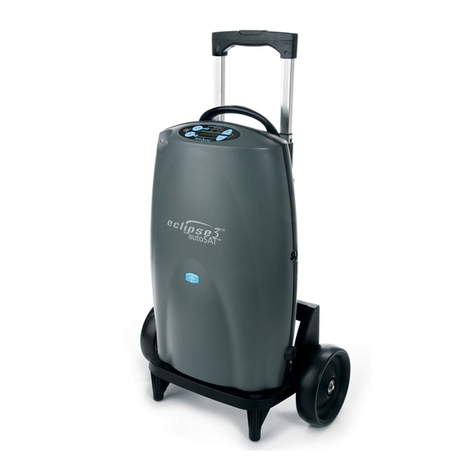MH EDS O2D1 User manual

Single Person
Electronic Digital Pulse-Demand
Aviation Oxygen Delivery System
MH EDS O2D1
H
Aviation Oxygen Systems
M
MOUNTAIN HIGH
Equipment & Supply Company INSTRUCTION MANUAL
4 mm Red inlet
connects to the
regulator
Power ON/OFF and
Mode Control Switch
(with read-out window)
6 mm Blue outlets
connect to cannula
or face mask
Static ports,
DO NOT
COVER
800-468-8185 • 541-923-4100 • Fax: 541-923-4141 • www.MHoxygen.com • 2244 SE Airport Way, Suite 100 Redmond OR 97756-7537
Patent # 6,220,244
Other Patents Pending
CONTENTS
INTRODUCTION
FEATURES
BASIC SAFETY
GETTING STARTED
MODE CONTROL SWITCH SETTINGS
AND MODES OF OPERATION
INSERTING OR REMOVING
THE BATTERIES 4
2
2
2
3
TROUBLE-SHOOTING
WARRANTY
SPECIFICATIONS
REMOVING THE TUBING
STORING THE MH EDS-O2D1
MOUNTING THE MH EDS-O2D1
USING THE MH EDS-O2D1 WITH A
THIRD PARTY REGULATOR
ALARMS AND ALERTS
4
4
4
5
7
6
6
7
8
Thank you for purchasing the MH EDS O2D1
Pulse-Demand Oxygen Controller. The MH EDS
O2D1 is patented oxygen control technology that
allows you and your co-pilot to fly with safety and
comfort, knowing it will automatically give the
oxygen required at the various altitudes.
THE EDS O2D1 IS DESIGNED FOR EASY
OPERATION, PLEASE CAREFULLY READ
THIS INSTRUCTION MANUAL BEFORE USE.
5MD10-0001-01 rev 4/5/12

2
2
INTRODUCTION
The patented MH EDS-O2D1 is an aviation oxygen delivery device for one person. It is designed to deliver aviation oxygen in the
most efficient, comfortable and convenient way possible. With its user-selectable settings, apnea alarm and small size, the MH
EDS-O2D1 is the most portable and flexible electronic digital oxygen delivery system in the world.
By providing a measured pulse of oxygen every time you breathe in, the MH EDS-O2D1 automatically supplies the oxygen you need
to stay alert and comfortable while flying. In contrast to constant flow systems that waste oxygen by supplying more than your
body can use, the MH EDS-O2D1 provides a short pulse of oxygen as you inhale, ensuring that your oxygen is used most efficiently.
Efficient oxygen delivery means you can fly further on a single oxygen refill or save space and weight with a smaller tank. It also
makes it more feasible to enjoy the advantages of oxygen while flying below the altitudes where oxygen is mandated--that can
mean fewer headaches, increased alertness, and feeling less exhausted when you reach your destination. Your actual oxygen usage
will be determined by your breathing rate and physiological needs at altitude.
The programmability of the MH EDS-O2D1 means that, unlike constant-flow oxygen systems, you can “set it and forget it”. By
automatically detecting your pressure altitude, the MH EDS-O2D1 can be set to start providing oxygen immediately or at a specified
altitude and will automatically adjust the oxygen flow as your altitude changes. When you’re flying, don’t you have more important
things to do than adjust your oxygen flow during altitude changes?
BASIC SAFETY
Pure oxygen is a highly oxidizing gas and can vigorously accelerate combustion. It can provide a catalyst for spontaneous
combustion resulting in personal injury or death if not used properly and with caution.
• Easy-to-use two-button control, small size and light weight
• Automatically adjusts oxygen ow for altitude pressure density.
• Provides reduced oxygen consumption through more efcient oxygen delivery than standard constant-ow systems
• Push button control switch allows automatic altitude enable, Night and Day operations and high ow settings
• Green/Yellow/Red LEDs indicate oxygen ow, alarm, and status
• Audible and visible apnea alarm informs user of kinked, pinched, or disconnected oxygen lines, obstructed cannula or mask
• Reduced dry mouth and sinus discomfort compared to constant-ow oxygen systems
FEATURES
6 mm Blue outlet connects
to cannula or face mask
4 Static ports,
DO NOT
COVER
4 mm Red inlet
connects to the
regulator
Power ON
and +Mode
Switch
Green/Amber/Red LED
indicator for User
Power OFF
and -Mode
Switch
•
DO NOT use any type of oil or grease on any of the fittings, valves or cylinders.
•
DO NOT smoke while in use.
•
DO NOT operate near an open flame.

3
GETTING STARTED
The MH EDS O2D1 is intended to be used with regulators provided by Mountain High. Some third-party oxygen regulators may
be used. See “Using a Third-Party Regulator” page 6 for details. Pilots who intend to fly with the MH EDS O2D1 are advised to
familiarize themselves and their passengers with the system prior to using it. Two cannulas and a face mask are included with
the MH EDS O2D1 unit. The cannula may be used for flight operations up to 18,000 ft. Above 18,000 ft., a face mask should be
worn. A compatible face mask with a built-in microphone is available from Mountain High.
Tote Bag
Face Mask MH EDS-O2D1 Unit
Oxygen Input
Tube
AA Batteries (Qty 2)
3M Dual-Lock™ Tape
Cannulas
1 standard, 1 ared tip
Instruction
Manual
Comfortable cannula position,
looped over ears
O2D1 with cannulas, regulator connection,
regulator and cylinder
1. If you have not already done so, fill your cylinder with
Aviation oxygen. (Many FBOs offer this service.)
2. Inventory your system (see photo) and read the front
label on the unit.
3. Read the instructions provided with your cylinder and regu-
lator, attach the regulator to the cylinder and hand tighten
only (DO NOT use a wrench or pliers.
The “O” ring seals the regulator to the
cylinder, and over tightening will damage
the regulator).
4. Open the battery cover on the back of the MH EDS-O2D1
unit, install the 2 AA batteries (supplied) and replace the
battery cover. (NOTE: Batteries fit tightly, handle with
care.) See next page for detailed instructions.
5. If you are using the MH EDS-O2D1 with a Mountain High
Four-Port regulator (FPR), locate the oxygen input tube (clear
tube with a short red tube on one end) and insert the Red
tube into the red “Oxygen In” connector on the MH EDS-
O2D1 unit until it stops (approx. 1/8 inch). Then connect the
other end of the tube to your regulator. If you are using a MH
single port regulator (XCR), use the tube that came with the
regulator in place of the tube that came with your MH EDS-
O2D1.
6. Insert the Blue end of the cannula or face mask tubing into
the blue “Out” connector on the unit.
(CAUTION: DO NOT pinch the Cannula or
Facemask tubing when inserting them
into the blue “Out” connectors). Use only
the supplied MH EDS cannula as other can-
nulas may not work properly with the MH
EDS-O2D1. DO NOT lengthen or shorten the
cannula tube.
7. Turn the cylinder valve on.
8. Push the “+” power/control button on the MH EDS-O2D1
unit once. This will turn the unit on and set it to “N” mode. A
start-up pulse of oxygen, LED light and beeper test will verify
battery power.
9. Don the cannula or face mask (make sure the face mask
seals against the skin) and take a breath. The bright green
LED should illuminate, and a pulse of oxygen should be
delivered. Refer to the card that comes with the cannula
or facemask for details on donning.
10.You are ready to fly.

4
5
4
TO INSERT THE TUBING, push tubing into collar until you
feel resistance, Then push in again approximately 1/4 inch
farther.
TO REMOVE THE TUBING, push in slightly on the tubing,
then push in the connector collar while you pull gently on the
tubing to remove it.
DO NOT pull on or remove the tubing without
pushing in the collar; it will damage the connector.
When not being used, the MH EDS-O2D1 unit, oxygen tubes, cannulas, etc., should be disconnected from the oxygen supply and
stored in a secure manner to ensure that dirt and debris do not enter the inlet and outlet tubes. The supplied tote bag or a zip-top
plastic bag is a good storage container. If the unit is not going to be used for 30 days or more, remove the
batteries. When using the unit for the first time after storage, check the batteries to ensure proper
operation. A set of fresh spare batteries should be part of your pre-flight inventory.
DO NOT store the EDS unit while the inlet is under pressure. Remove all sources of oxygen pressure and secure the
unit to ensure it will not become damaged. If the lines are disconnected they must be covered so that debris, dust or dirt can’t get
in. If the supply line is left hooked to the system, make sure that it is first purged with clean dry air or oxygen before the EDS unit is
connected. If the lines are disconnected they must be covered so that debris, dust or dirt can’t get in.
MOUNTING THE MH EDS-O2D1
You may mount the MH EDS-O2D1 unit to a suitable place using the supplied piece of 3M DUAL LOCK tape. Peel the protective
backing off one of the rectangles to expose the adhesive and apply it to the back of the unit above the thumb indent for the bat-
tery door. DO NOT COVER ANY PART OF THE BATTERY DOOR. When a suitable place to mount the unit has been found, peel off the
protective adhesive backing on the other rectangle and press the adhesive side to the chosen mounting area. Let the adhesive
cure for 12 hours before attempting to remove the two halves of the Dual-Lock from each other, or
the adhesive may pull away from the unit or mounting area.
INSERTING AND REMOVING THE BATTERIES
STORING THE MH EDS-O2D1
1. Push in the collar
2. Pull the tube
straight back
while pushing
in the collar.
INSERTING AND REMOVING THE TUBING
Remove the battery door by pressing down gently on the battery cover flange
then slide the door out and away from the unit. The O2D1 unit uses two (2)
standard AA alkaline batteries. Insert the batteries as shown on the label
inside the battery compartment (they will be a tight fit), then replace the door
by sliding the door into place until it snaps in place. Take care when removing
and replacing the batteries as to not damage the batteries and/or connectors.
Recommended Batteries: 2 each 1.5 volt DURACELL ULTRA alkaline
batteries type ‘AA’ or equal quality equivalent.
Battery Life: 100 Hrs. @ ~25° C. @ ~25% R.H. Measured from
mean, assuming fresh DURACELL ULTRA alkaline batteries operating under
normal operating conditions.
Batteries should be replaced annually or when voltage is low.

5
5
This last switch setting, R/M, for “Reserve” or “Manual” provides the maximum oxygen
flow regardless of altitude. The pulse duration does not vary with altitude.
Flow start: All altitudes Use with: Cannula or face mask
Flow amount: Maximum Altitude Compensating?: No
The MH EDS-O2D1 unit is controlled by two push button control switches.
A stop inside the selector switch prevents inadvertently turning the unit
off in flight.
MODE CONTROL SWITCH SETTINGS AND MODES OF OPERATION
N MODE: “Night” or “Now”
At this setting the MH EDS-O2D1 will immediately start the standard oxygen flow providing
pulses of oxygen appropriate for an average healthy person using a cannula.
Flow start: All altitudes Use with: Cannula
Flow amount: Standard Altitude Compensating?: Yes
D MODES: “Day” or “Delayed”
F MODES: “Face Mask”
The F mode settings (F5, F10, F15, and F20) are called the “Face mask” settings.
They supplement the standard oxygen flow with a richer flow by adding approximately the
selected number of feet (in thousands) to the MH EDS-O2D1’s perceived altitude.
Flow start: All altitudes Use with: Cannula or face mask
Flow amount: Altitude Compensating?: Yes
Enriched: F5 =Standard+5,000 ft
F10=Standard+10,000 ft
F15=Standard+15,000 ft.
F20=Standard+20,000 ft.
Example: If you are at a pressure altitude of 5,000 ft. and select the F10 setting you will receive
the effective flow rate of 5,000 + 10,000 = 15,000 ft. The “F” modes are useful for people for
whom the standard oxygen supply does not achieve the desired blood oxygen saturation or for
those who prefer to use a face mask rather than a cannula.
N
OFF
R/M
The MH EDS-O2D1 has three main modes of
user controlled operation:
1. Fully-Automatic (D5, D10)
2. Semi-Automatic (N and F modes)
3. Manual (R/M)
The D5 setting will cause the MH EDS-O2D2 unit to delay oxygen flow until it senses
a pressure altitude of 5,000 ft. and above. The D10 setting delays oxygen flow until
10,000 ft. and above. NOTE: When the barometric pressure is low, it will start operation
at a slightly lower altitude than when the barometric pressure is high.
Flow start: D5--5,000 ft., D10--10,000 ft. Use with: Cannula
Flow amount: Standard Altitude Compensating?: Yes
D5
Advance
(+)
Push Button
Reverse
(-)
Push Button
Switch as seen in the
”OFF” setting
Control switch settings
F15
NOTE: The N and D modes are designed to provide the amount of oxygen needed by an aver-
age size healthy person using a cannula at the given altitudes; your needs may be different. To
determine whether you are receiving enough oxygen in a particular mode you will need to use a
pulse oximeter (available from Mountain High) to determine your blood oxygen saturation (goal is
90-100%) at any given altitude. In all modes (except R/M), the O2D1 provides a pulse of oxygen
which increases with altitude, i.e., it is altitude compensating.
R/M: “Reserve/Manual”

6
6
The MH EDS O2D1 is equiped with AUDIO-VISUAL ALARMS and ALERTS designed to bring to the user’s
attention potential malfunctions of the unit. Read the following for specifics.
ALARMS AND ALERTS
POWER UP
POWER-UP: Red Light flashing on and off with audio chime for ~ two (2) seconds with each initial power-up with pulse of
O2for about 1/2 second.
O2 DELIVERY or NON-DELIVERY: Normally one flash of the LED Green Light (~1/4 second minimum) will flash for each
pulse of oxygen with a valid inhalation event with properly connected oxygen lines. NOTE: The O2D1 FLOW-FAULT (see
FLOW-FAULT below) indicator will not function as an out-of-oxygen warning if the pressure in the oxygen cylinder is 500 psi or
less. There may be pressure in the oxygen line but not enough to activate the Pulse-Demand unit, consequently...no FLOW-FAULT
warning. Prior to flying, using the cylinder chart, the pilot should estimate his flight altitude and time to determine the amount
of oxygen that he or she will need. It is better to have more than your estimated need. If a pilot consistently flies above 18,000
feet, the aircraft should have a supplementary gauge, visible during flight by the pilot, to determine the cylinder oxygen pressure.
You should also carry an EOS (Emergency Oxygen System) such as the MH Co-Pilot as a back-up safety feature in case the other
system stops working. It is the absolute responsibility of the pilot to determine that there is an adequate amount of oxygen
pressure in the oxygen cylinder prior to his flight, as well as an emergency back-up in case of a system failure. The oxygen sys-
tem must be checked and tested ON THE GROUND before the flight.
O2DELIVERY or NON-DELIVERY
FLOW-FAULT EVENT: The LED Red Light will flash on and off along with a Hi-Lo audio chime for ~ 2 seconds with every
event. NOTE: The FLOW-FAULT is not intended as a low or out-of-oxygen warning. It is only intended to warn the pilot that
there is no oxygen flowing to the EDS O2D1 unit. This typically means that the cylinder valve was not opened, or the supply
line has been pinched closed, or is plugged up, or has come off, or the valve in the O2D1 has failed to open.
FLOW FAULT EVENT
APNEA EVENT: Flash Amber Light four (4) discrete times with audio beeps once every four (4) seconds until unit detects
a valid inhalation event. Time before Apnea event is ~30 ~35 seconds. This typically occurs for the following reasons: (1) The
user has quit breathing for 30 - 45 seconds or the cannula/face mask is improperly worn. (2) The outlet tube from the MH EDS-
O2D1 to the mask or cannula has become disconnected. (3) The outlet tubing has become pinched closed or is plugged off.
The apnea alarm can be used as a “put-your-oxygen-on” alarm once you get to the preset D mode altitude (D5 or
D10). In this case, the alarm will not sound if you already have the cannula or face mask on properly.
APNEA EVENT
USING THE MH EDS-O2D1 WITH A THIRD-PARTY REGULATOR
LOW BATTERY -1: Depending on battery condition, one short flash of the Red Light once every second, no sound. The
unit will continue to operate properly for about four hours @ 77°F (25°C) after the indicator starts to flash. The EDS-O2D1 will
operate for ~ 100 hours with a fresh set of DURACELL ULTRA alkaline batteries under normal operation.
LOW BATTERY-1 (First Warning)
LOW BATTERY -2: Two short flashes of the Red Light once every second, no sound. When this alarm occurs, the unit may
operate for about 45 to 60 minutes, then the oxygen flow will stop and may go into the Bad Battery Mode. BATTERIES
SHOULD BE REPLACED IMMEDIATELY. The EDS-O2D1 will operate for ~ 100 hours with a fresh set of quality alkaline
batteries under normal operation.
LOW BATTERY-2 (Second Warning)
BAD BATTERY: Flashing Red Light on and off at a one (1) second rate with unit locked out, no sound. BATTERIES
SHOULD BE REPLACED IMMEDIATELY!
BAD BATTERY
If the EDS-O2D1 will not be used with a MH Regulator, the alternate regulator must be able to deliver a
pressure of between 15 and 25 psi (static). If the above listed pressure specifications are not met, the EDS-
O2D2 may not operate correctly. Lower pressures will result in an inadequate volume of oxygen. Higher pressures will
result in a too high volume of oxygen. Excessively high pressures will cause the valve to open spontaneously and leak oxygen.
To use the MH EDS-O2D1 with a third-party regulator or built-in oxygen system with a pressure higher than 25 psi, it is
mandatory that you use the MH EDS IN-LINE REGULATOR to ensure correct flow pressure.The EDS-ILR goes between the third-
party regulator or built in system and the MH EDS-O2D1 to reduce the flow pressure to an appropriate level.

77
The O2D1 unit emits no sound or start-up oxygen pulse when turned on:
1. Check batteries to make certain they are fresh.
Start-up sound is heard, but no start-up oxygen pulse delivered:
1. Check oxygen cylinder valve is on.
2. Check oxygen supply tube for proper connection.
3. Check oxygen supply tube for obstructions.
4. Check O2D1 outlet tubing for obstructions.
When using the face mask, no oxygen pulse on inhalation:
1. Make sure the face mask is sealed against the skin.
2. Check for obstructions on the O2D1 outlet tubing.
3. Use only face masks provided by Mountain High Equipment & Supply.
NOTE: EDS face masks DO NOT have a plastic dilution bag attached
Oxygen pulses are delivered, but an alarm is heard at the same time:
1. Check the battery to make certain it is fresh.
2. Check for obstructions in the cannula/mask and tubing.
3. Use only masks and cannulas supplied by Mountain High Equipment & Supply.
The O2D1 does not trigger at higher altitudes:
1. Try using the Flared-Tip cannula included with the kit (MH part number 00EDS-1084-01)
TROUBLE-SHOOTING
•
•
•
•
•
WARNING
DO NOT
increase or
decrease length
of cannula or
face mask
supply tubing.
LIMITED WARRANTY
This device is classified as, and is only suitable for use as, a supplementary breathing apparatus (SBA) for aviation use. It is intended to
help supply the needed amount of oxygen for persons during flight altitudes where supplemental oxygen is needed. This device is not
suitable for any type of life support operations. This device is not suitable for SCBA (Self Contained Breathing Apparatus), SCUBA (Self
Contained Underwater Breathing Apparatus) or any medical operations.
Before it is put to use, it is the responsibility of any user who will use this device to become familiar with the operation and safety aspects
of this device. Using the system improperly could cause failure and lead to possible property damage and/or personal injury.
Mountain High Equipment & Supply Company assumes no responsibility for property damage, accidents, injury or death that may result
from the misuse of this device/equipment. This includes any use of this device/equipment outside the scope of common sense, the
Instruction Manual, inserts and other related documentation.
NOTICE OF NON-LIABILITY
Mountain High Equipment & Supply Company warrants your MH EDS-O2D2 unit against defects in materials and workmanship for two (2)
years from date of purchase invoice. The warranty is non-transferable. Should any part of the MH EDS-O2D2 become defective within the war-
ranty period return the EDS Unit with a description of what/why it is not functioning and we will repair or replace it, at our discretion, free of
charge (you pay only shipping to MH).
Return the Unit to:
Mountain High Equipment and Supply Company
RRO Department
625 SE Salmon Avenue Suite 2
Redmond OR 97756-8696
This warranty is non-transferable and only valid if Mountain High Equipment & Supply Company determines that the system and its
components have not been damaged due to improper use, been submerged in fluids, dismantled or abused. Mountain High Equipment &
Supply Company reserves the right to determine if repairs are to be done under warranty or at a nominal charge. To activate warranty
coverage, you must complete and return your owner’s enclosed EDS Registration Card.

8
SPECIFICATIONS
8
8
Allowable respiration rates: Adaptive: up to 43 bpm. And down to ~ 5 bpm. (two persons independently)
Apnea time-out envelope: Adaptive: ~40 sec Pa. 0-12 K ft., ~30 sec. Pa. 13-18 K ft., 20 Sec. at and above Pa. 18 K ft. Apnea
alarm does not respond if in any of the ‘D’ modes and while below that pressure altitude threshold.
Operating inlet pressures: 15 psig. (1 bar) DYNAMIC (owing) through cannula and 1.5 meters (5 ft.) of 4 mm. inlet tubing.
25 psig. (1.72 bar) .
Operating & storage temperatures, altitudes, vibration @ humidity, (assumes nominal operating voltage):
Temp range @ ~10% RH: -40° to +60° C. (Storage for complete unit less battery)
Temp range @ ~25% RH: 0° to +60° C. (Operating with std. valve)
Temp range @ ~100% RH NC: +5° to +60° C. (Operating with std. valve) Unit is not water-proof, keep it dry from
spray & rain.
Altitudes @ up to ~100% RH: -100 to +30 K ft. Pressure Altitude range @ +5° to +60° C. (Operating with std. valve)
Vibration: Random vibration 5 to 500 Hz, 15 minutes per axis @ 2.5 g. (rms) sin wave.
Physical characteristics (EDS-O2D1 unit only):
Width @ widest point: 3.11” (79 mm);
Height, including connectors: 5.23” (130 mm.);
Height, enclosure only: 4.62” (117 mm);
Thickness, front to rear: 0.95” (24.15 mm)
Weight: 8.2 Oz. (0.233 kg.) with batteries
Operating Voltage & Current @ 25° C. @ ~25% RH.
(Measured in the ‘N’ mode setting @ 15 RESP/ typical.):
Battery types: 2 each 1.5 volt alkaline type ‘AA’
DURACELL ULTRA alkaline batteries or equivalent.
Battery Life: 100 Hrs. @ ~25° C. @ ~25% R.H. Measured from
mean, assuming fresh DURACELL ULTRA alkaline batteries operating under normal operating conditions.
NOTE: Make sure alkaline batteries are used and removed during long-term storage.
Nominal battery voltage: ~2.875 VDC ± 40 mv.@ 2.25 ma. Idle. 100 ma. Peak (~50 ms. max), 3.25 ma. Average.
Min. start-up voltage: ~2.5 VDC ± 40 mv.
Low-battery cut-out: < 2.0 VDC ± 40 mv. (Red light on steady unit in non-responsive state ‘dead’)
Very low battery signal: ~2.25 VDC ± 40 mv. (Red light winking 2/sec.) ~5 Hrs. of service left.
Low battery signal: ~2.4 VDC ± 40 mv. (Red light winking 1/sec.) ~12 Hrs. of service left.
Notes:
The low battery cut-out feature provides a known state of action if the batteries are depleted to the point of inadequate power to operate
the unit to any of the declared specications. In addition, this feature was found to be prudent because, while many of the specications may
stay intact, false triggering of the valve may confuse the operator of a problem other than low batteries. The minimum ‘start-up’ voltage is
where the unit will initiate the built-in test and commence operations. However, it should be noted that, during this operation, if the batteries
are then measured to be too low the lock-up feature may then shortly ensue. This should help the operator in determining if the unit is bad or
if the batteries are too low. A unit that has low batteries that cause ‘lock-up’ will most likely initially start-up if left off for some time. Alkaline
type batteries have so-called self-rejuvenating properties that may cause the user to stall battery replacement. Obviously, dead batteries will
yield no action.
The O2D1 Specifications, performance standards and limits are derived from actual units tested,
characterized or calculated. Specifications are subject to change without notice.
Height
Depth
Width
16 mm
800-468-8185 • 541-923-4100 • Fax: 541-923-4141 • www.MHoxygen.com • 2244 SE Airport Way, Suite 100 Redmond OR 97756-7537
Table of contents
Other MH Oxygen Equipment manuals
Popular Oxygen Equipment manuals by other brands
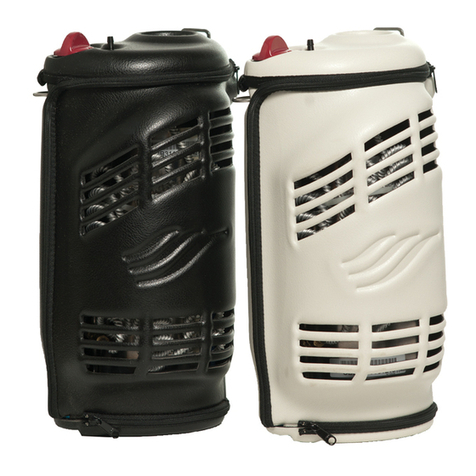
C-Aire
C-Aire HI Flow operating instructions
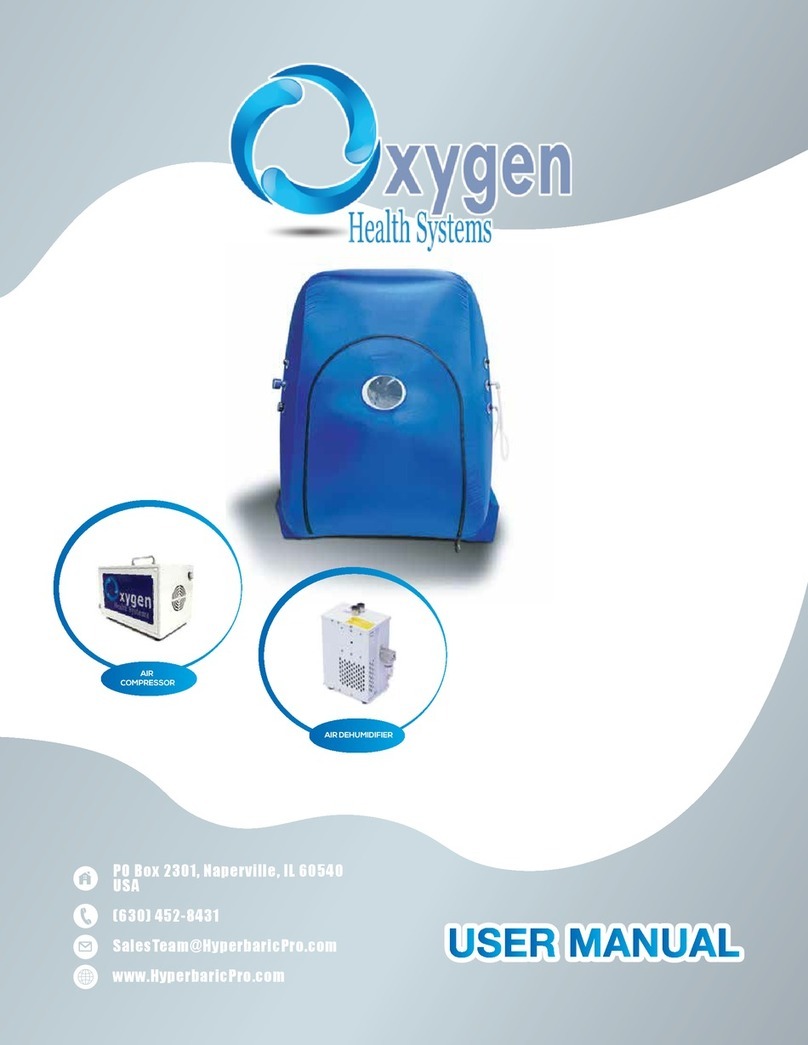
Oxygen
Oxygen Wheel Chair Ready Type Chamber user manual
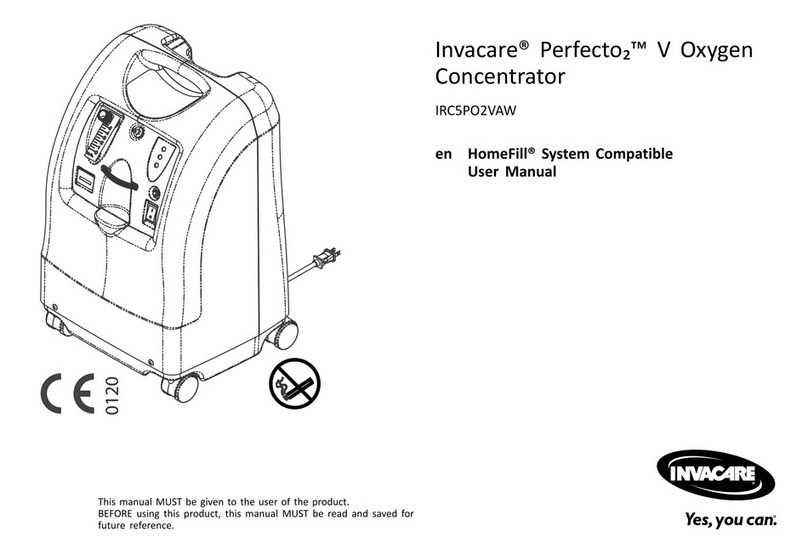
Invacare
Invacare Perfecto2 V user manual

Suburban
Suburban OXYGEN THERAPY DOOR 12155-00-DRDRAA owner's manual
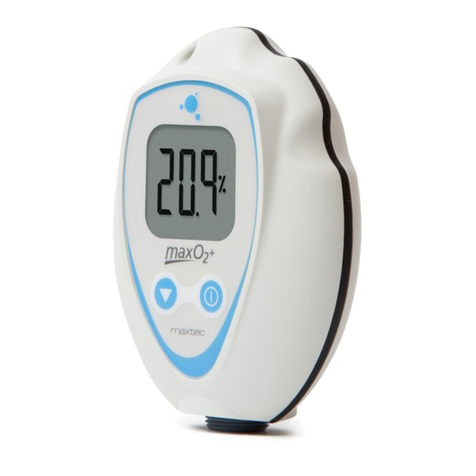
Maxtec
Maxtec MAXO2+A Industrial Guide & Operating Instructions
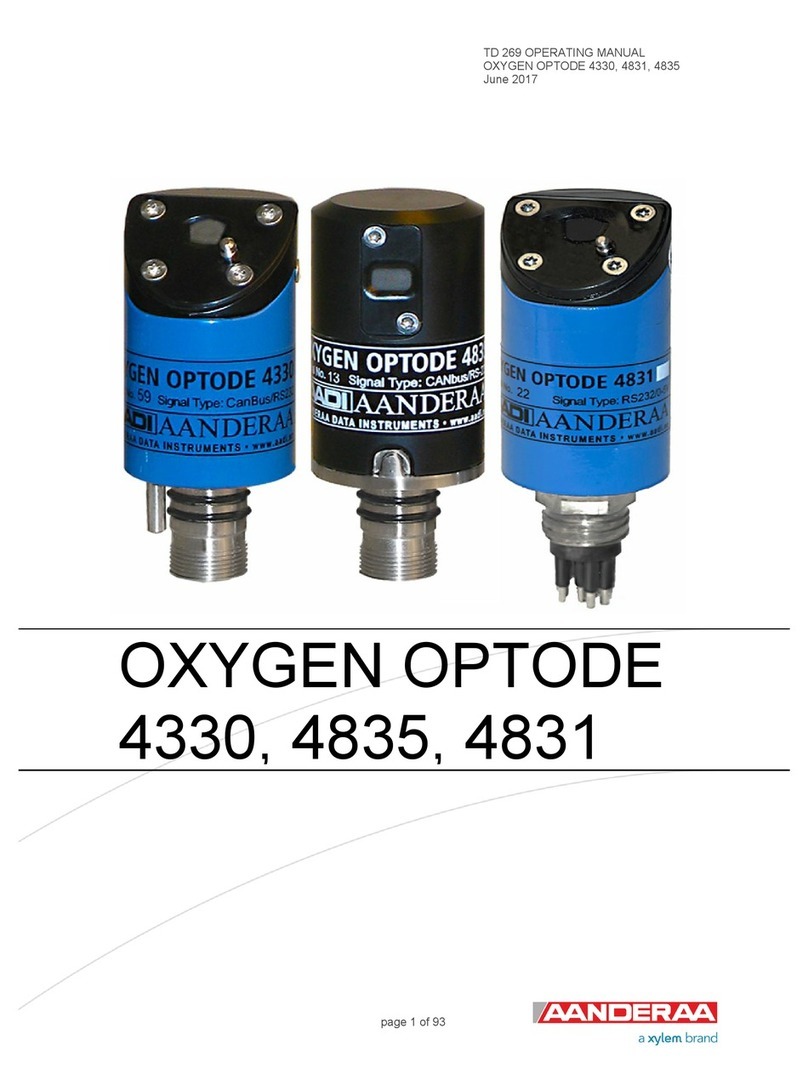
Aanderaa
Aanderaa 4330 operating manual
